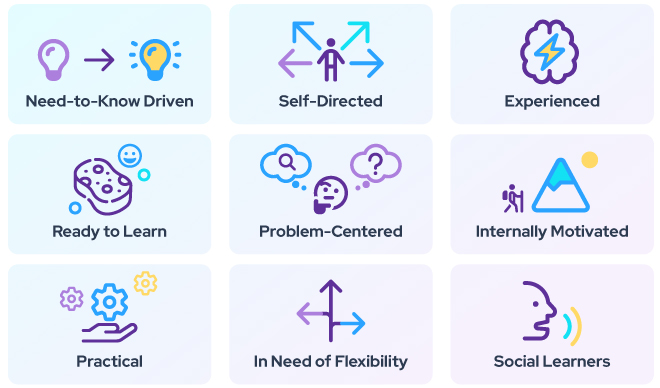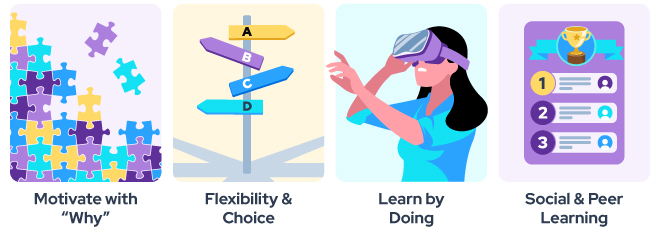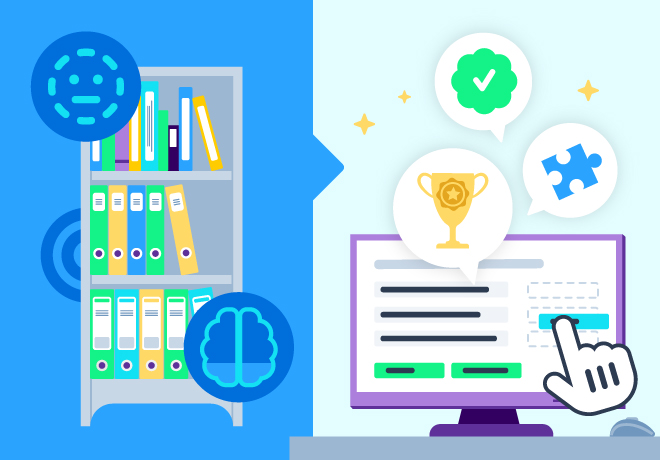
Adult Learning Principles in Action: Designing Training That Actually Works

Related articles
Get valuable eLearning insights to your inbox.
Listen to Neovation’s Demystifying eLearning podcast generated with NotebookLM!
Listen to our podcast on your favorite platform!
Why do so many corporate training programs fail to make a lasting impact? Often, it’s because they are designed without considering the single most important factor: how adults actually learn.
To create training that truly resonates, drives change, and provides a return on investment, we must build it on the foundation of proven adult learning principles. By aligning your training with adult learning theory and instructional design, you can move beyond passive, one-size-fits-all modules and create programs that stick.
This guide will walk you through the essential principles that are key to designing training that actually works—programs that engage learners, respect their experience, and lead to meaningful, long-term skill development.
What Are Adult Learning Principles?
Adult learning principles, often called the principles of adult learning theory, are a set of guidelines based on the theory of andragogy that explain how to design effective training. At their core, these principles of adult learning recognize that adult learners are:

- Need-to-Know Driven: They must understand the "why"—the direct purpose and value of the training.
- Self-Directed: They prefer having control over their own learning path and decisions.
- Experienced: Their past experience is a rich resource that should be integrated into the learning process.
- Ready to Learn: They are most receptive when a topic is immediately relevant to their current needs or roles.
- Problem-Centered: They prefer learning practical skills that can be applied to solve real-world problems.
- Internally Motivated: They are driven more by internal factors like personal growth and job satisfaction than external rewards.
- Practical: They need to see how new skills can be applied on the job right away.
- In Need of Flexibility: They value having choices in the format, pace, and timing of their learning.
- Social Learners: They learn effectively from others through mentorship and peer collaboration.
Building your training on this foundation doesn't just create better courses—it yields tangible benefits for your learners and your entire organization.
Why adult learning principles matter in organizational training
Aligning corporate training with the core principles of adult learning and instructional design is crucial because today's employees demand relevant, flexible, and practical learning. Honoring these principles delivers four key business benefits:
- Increased Engagement: Learners become active participants, not passive listeners.
- Higher Knowledge Retention: Practical, relevant skills are retained for long-term use.
- Real-World Application: Training translates directly into improved on-the-job performance.
- Stronger Training ROI: Engaged, skilled employees deliver a clear return on your training investment.
These benefits are not just theoretical; they are the direct result of putting adult learning principles into action through specific, real-world training applications.
Principles of Adult Learning in Action: Real Training Applications
Applying each adult learning principle in a practical way is how you move from theory to effective training design.

Frame the "why" to boost motivation
Begin by clearly stating the learning outcomes and direct benefits, using intro videos to establish the purpose and relevance of the training. This ensures all content is directly connected to the employee's on-the-job challenges and long-term career goals.
Empower learners with flexibility and choice
Empower learners by offering content in multiple formats on a self-paced, mobile-friendly platform, complete with personalized learning paths and branching scenarios. Incorporate discussion forums and peer collaboration to leverage the rich experience that learners bring with them.
Emphasize "learning by doing"
Design practical activities around realistic case studies and role-playing, and incorporate risk-free simulations for valuable hands-on practice. Adding gamified elements like badges or leaderboards can further boost engagement and drive participation in these challenges.
Encourage social and peer learning
Foster a collaborative learning culture by establishing formal mentorship programs and hosting expert-led webinars for internal knowledge sharing. Creating dedicated social learning channels or "coaching pods" provides an ongoing space for peer-to-peer support and problem-solving.
Implementing these positive strategies is half the battle; the other half is using adult learning theory to proactively avoid the common pitfalls that cause training programs to fail.
Avoid These Training Pitfalls By Applying Adult Learning Principles
Many common training mistakes stem from ignoring the fundamental tenets of adult learning theory principles. Here are four major pitfalls and how to avoid them:
The "classroom lecture" approach
The Pitfall: Designing training as a linear, top-down lecture where learners are expected to passively absorb information. This pedagogical approach is a holdover from childhood education and is deeply disengaging for adults.
The Solution: Replace the one-way lecture with self-paced online modules, a mix of content formats (video, text, interactive), and activities that give learners control over their experience.
Information overload without application
The Pitfall: Overloading employees with dense theory and information they can't use immediately. Without a practical application, this knowledge has no context and is quickly forgotten.
The Solution: Structure training around solving real-world challenges. Focus on actionable skills and include hands-on activities, case studies, or simulations that allow for immediate practice.
The "Blank Slate" Fallacy
The Pitfall: Treating experienced professionals like empty vessels who have no prior knowledge. This approach can feel condescending and misses a valuable opportunity to create deeper learning connections.
The Solution: Design activities like group discussions, peer-to-peer coaching, and mentorship opportunities that encourage learners to share their expertise and connect new concepts to what they already know.
The One-Size-Fits-All Program
The Pitfall: Creating a generic, non-interactive program that fails to address the specific needs, roles, and goals of individual learners. If the content isn't relevant to them, they will tune out.
The Solution: Use personalized learning paths, branching scenarios, and interactive quizzes to tailor the experience. Allow learners to choose the content and activities that are most applicable to their own development goals.
To see how a real organization avoided these pitfalls and achieved success, let's dive into a case study of these adult learning principles in action.
Case Study: Neovation, WSP, and Adult Learning Theory in Action
Neovation Learning Solutions partnered with WSP to transform its training for 65,000 global employees, making it more engaging and effective by grounding the strategy in the Malcolm Knowles principles of adult learning.
- For Engagement & Practicality: Neovation built interactive simulations and hands-on activities, allowing employees to practice real-world tasks in a risk-free environment.
- For Self-Direction & Flexibility: They converted live training into self-paced online modules, giving employees control over when and where they learn.
- For Relevance & Experience: By working with WSP’s experts to adapt existing materials, they ensured the new content was relatable and directly applicable to employees' roles.
This strategic approach was highly successful, earning a 95% favorable rating from WSP's learners and creating a more effective and accessible training program.
Your Blueprint for Effective Adult Learning
Ultimately, understanding adult learning theory principles is the key that unlocks corporate training that drives real performance. By shifting from a top-down, lecture-based approach to one that is practical, relevant, and respects the learner's own experience, you create programs that boost engagement, increase retention, and deliver a powerful return on investment.
As the WSP case study demonstrates, this isn't just theory—it's a proven strategy for success. Putting this blueprint into action can be a complex task, but you don't have to do it alone. Neovation's Custom Learning team specializes in leveraging adult learning principles to help organizations like yours design and build effective training that inspires real change and delivers lasting results.

Alex is an experienced writer and marketer with an interest in all things education. With a background in literary theory, technical writing, and document design, he is interested in how learners make meaning from language and how to create meaningful connections through writing.
Become part of our L&D community
We publish a new learning hub article — full of useful, practical topics — weekly.
Not sure where where you want to start? Jump into one of our recently published articles and see where it takes you!








-svg.svg)
-svg.svg)
-svg.svg)
-svg.svg)